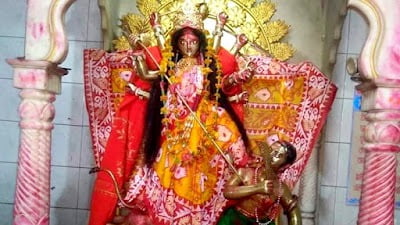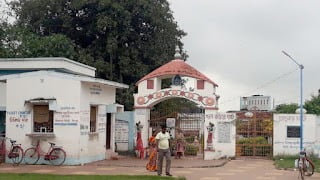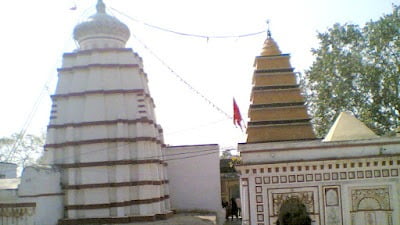Bakreshwar Temple | Mahishmardini Shaktipeeth West Bengal
Bakreshwar Shakti Peeth is a renowned Hindu pilgrimage site located in the Birbhum district of West Bengal, India. It is considered one of the 51 Shakti Peethas, which are sacred sites dedicated to the worship of the divine feminine energy or Devi.

According to Hindu mythology, it is believed that the left ankle of the goddess Sati fell at this location when Lord Vishnu used his Sudarshan Chakra to cut her body into pieces, following her self-immolation in the Daksha Yajna. Therefore, this temple is considered a significant place of worship for devotees of the Hindu Goddess.
The main deity of the Bakreshwar temple is Goddess Mahishmardini, an incarnation of Goddess Durga. The temple complex consists of several temples dedicated to different deities, including Mahishmardini, Bhairav, and Lord Shiva. The temples are constructed in the Bengali terracotta style of architecture, showcasing intricate artwork and craftsmanship.
It is not only a place of religious significance but also a place known for its natural hot springs. The hot springs are believed to have therapeutic properties, and pilgrims often take a dip in these waters as a part of their spiritual journey.
Every year, during the Hindu festival of Navaratri, the Mahishmardini Shaktipeeth witnesses a significant influx of devotees from various parts of the country who come to seek the blessings of the goddess. The atmosphere is vibrant with religious fervor and cultural activities during this time.
Visiting this Shakti Peeth provides devotees with a unique spiritual experience, combining the religious significance of the Shakti Peetha with the natural beauty of the region. It offers a peaceful and serene environment for devotees to connect with the divine and seek blessings.
Read More>> Attahas Temple Birbhum Shaktipeeth
Contents
- 1 History of Bakreshwar Temple:
- 2 Miracles of Bakreshwar Temple:
- 3 FAQ:
- 3.0.1 What is Bakreshwar Temple?
- 3.0.2 Why is Bakreshwar Temple famous?
- 3.0.3 What is Bakreshwar Mela?
- 3.0.4 How old is Bakreshwar Temple?
- 3.0.5 Are there any rituals associated with Bakreshwar Temple?
- 3.0.6 What are the medicinal properties of the hot springs at Bakreshwar Temple?
- 3.0.7 Is there any historical significance associated with Bakreshwar Temple?
- 3.0.8 What is the architecture of Bakreshwar Temple like?
- 3.0.9 Is there an entrance fee to visit Bakreshwar Temple?
- 3.0.10 How to reach Bakreshwar Temple?
- 3.0.11 What are the nearby attractions to Bakreshwar Temple?
- 4 How to reach Bakreshwar temple:
- 5 Google Maps:
History of Bakreshwar Temple:
The history of Bakreshwar Shakti Peeth is rooted in Hindu mythology and legends associated with the goddess Sati and Lord Shiva. According to the ancient scriptures and Puranas, here is the story behind the origin of the Shakti Peeth:
The legend begins with the marriage of Lord Shiva, one of the principal deities in Hinduism, to the beautiful goddess Sati, who was the daughter of King Daksha. King Daksha organized a grand yajna (sacred fire ritual) but deliberately did not invite Lord Shiva due to his disapproval of their marriage. However, Sati, being the dutiful wife, decided to attend the yajna despite Shiva’s warning.
Upon reaching the yajna, Sati was mistreated and insulted by her father Daksha. Unable to bear the humiliation, Sati immolated herself in the ceremonial fire. Lord Shiva, upon hearing the news, was overcome with grief and anger. He then unleashed his destructive power and carried Sati’s burnt body across the universe in a state of deep mourning.
While Lord Shiva was wandering, grief-stricken, with Sati’s body, Lord Vishnu intervened to alleviate his pain. Vishnu used his Sudarshan Chakra (a divine weapon in the form of a discus) to dismember Sati’s body into pieces. These pieces fell at various locations across the Indian subcontinent, which came to be known as Shakti Peethas.
In the case of this Shakti Peeth, it is believed that the left ankle of Sati fell at this place. The word “Bakreshwar” is derived from the Sanskrit words “Bakra” (meaning ankle) and “Ishwar” (meaning Lord). Thus, Mahishmardini Shaktipeeth became the sacred site where the left ankle of the goddess is worshipped.
Over the centuries, the site of this temple is developed into a significant place of worship and pilgrimage. Devotees flock to the temple complex to offer prayers and seek blessings from Goddess Mahishmardini, an incarnation of Goddess Durga, who is worshipped as the presiding deity of the Shakti Peeth.
The history and legends associated with this Shakti Peeth have contributed to its spiritual significance and the popularity it enjoys among devotees, who visit the site to connect with the divine and seek divine blessings.
Read More>> Gayatri Shaktipeeth Chitrakoot Temple

Miracles of Bakreshwar Temple:
Bakreshwar Shakti Peeth is believed to be a sacred site where miracles and divine interventions have been reported by devotees over the years. While it’s important to note that miracles are a matter of personal faith and belief, here are a few instances that have been attributed to the blessings of the goddess at this temple:
Healing from ailments: Many devotees believe that taking a dip in the natural hot springs of Bakreshwar can have therapeutic effects on various physical ailments. The hot springs are said to possess medicinal properties and are believed to help in the healing of skin diseases, joint pains, and other ailments.
Fulfillment of wishes: Devotees often visit to offer their prayers and seek the blessings of the goddess. It is believed that the goddess Mahishmardini listens to the sincere prayers of her devotees and fulfills their wishes. Devotees have reported experiencing positive changes in their lives, such as success in endeavors, resolving personal problems, and finding peace and harmony.
Protection and safety: Many devotees believe that seeking the blessings of the goddess can provide protection and safety from various dangers and obstacles. They have shared stories of being safeguarded from accidents, illness, and other life-threatening situations after offering prayers and seeking the divine intervention of the goddess.
Spiritual experiences: Some devotees have reported having profound spiritual experiences while visiting Bakreshwar Shakti Peeth. They claim to have felt a deep connection with the divine energy of the goddess and experienced a sense of inner peace, bliss, and spiritual awakening.
It’s important to remember that these accounts are based on personal beliefs and experiences. The miracles associated with this Shakti Peeth hold significance for devotees who have experienced them firsthand or have heard about them through their faith community. The power of faith and devotion plays a crucial role in the perception of these miracles.
Read More>> Tripura Sundari Temple in Tripura
Bakreshwar temple timing:
Here are the specific timings for each day of the week:
Monday to Friday: 5:30 AM to 7:00 PM
Saturday: 5:30 AM to 8:00 PM
Sunday: 5:30 AM to 8:00 PM
Public Holidays: 5:30 AM to 8:00 PM

FAQ:
What is Bakreshwar Temple?
Bakreshwar Temple is a renowned Hindu temple located in the Bakreshwar village of Birbhum district in West Bengal, India. It is dedicated to Lord Bakranath, a form of Lord Shiva.
Why is Bakreshwar Temple famous?
Bakreshwar Temple is famous for its natural hot springs and the annual Bakreshwar Mela. It is considered a holy pilgrimage site and is believed to have medicinal properties due to the healing qualities of its hot springs.
What is Bakreshwar Mela?
Bakreshwar Mela is an annual fair held at the Bakreshwar Temple during the Bengali month of Phalgun (February-March). Devotees from various regions gather here to take a dip in the hot springs and seek blessings.
How old is Bakreshwar Temple?
The exact age of Bakreshwar Temple is uncertain, but it has a long history and is believed to date back to ancient times. The temple has undergone renovations and reconstructions over the centuries.
Are there any rituals associated with Bakreshwar Temple?
Yes, various rituals and pujas are performed at Bakreshwar Temple. Devotees offer prayers, light lamps, and take holy dips in the hot springs as a form of worship. The temple also conducts special pujas during festivals.
What are the medicinal properties of the hot springs at Bakreshwar Temple?
The hot springs at Bakreshwar are known for their sulfur content and are believed to have healing properties. It is said that bathing in these springs can relieve certain skin ailments and joint pains.
Is there any historical significance associated with Bakreshwar Temple?
Bakreshwar Temple is considered a sacred site mentioned in ancient texts, and it has been associated with mythological legends. The temple’s historical and cultural importance adds to its significance.
What is the architecture of Bakreshwar Temple like?
The architecture of Bakreshwar Temple is predominantly traditional Bengali temple architecture. It features a spire and intricate terracotta designs on its walls, depicting various mythological stories.
Is there an entrance fee to visit Bakreshwar Temple?
As of my last knowledge update in September 2021, there was no specific entrance fee to visit Bakreshwar Temple. However, it’s a good idea to check for any updated information regarding entry fees and regulations before your visit.
How to reach Bakreshwar Temple?
Bakreshwar Temple is accessible by road. It’s located about 15 kilometers from the town of Siuri in Birbhum district. The nearest major city is Kolkata, and you can reach Bakreshwar by road via Siuri or other nearby towns.
What are the nearby attractions to Bakreshwar Temple?
Birbhum district in West Bengal has several attractions apart from Bakreshwar Temple. Some of the nearby places of interest include Tarapith, Nalhati, and the Shantiniketan, which is associated with Rabindranath Tagore.
How to reach Bakreshwar temple:
By Air: The nearest airport is the Netaji Subhas Chandra Bose International Airport in Kolkata. From the airport, you can take a taxi or bus. The journey time is approximately 2 hours and 30 minutes.
By Rail: The nearest railway station is the Bakreshwar Railway Station. There are direct trains from Kolkata, Durgapur, and other major cities in West Bengal. The journey time from Kolkata is approximately 3 hours.
By Road: Mahishmardini Shaktipeeth is well-connected by road to all major cities in West Bengal. You can take a bus or a taxi from Kolkata, Durgapur, or any other major city. The journey time from Kolkata is approximately 4 hours.
Once you reach Bakreshwar, you can walk to the temple, which is located in the heart of the town. The temple is also accessible by rickshaw or taxi.
Here are some of the road routes to reach Bakreshwar Temple from different parts of India:
From Kolkata: Take NH16 to NH34. The total distance is approximately 240 kilometers and the journey time is around 4 hours.
From Durgapur: Take NH14 to NH34. The total distance is approximately 150 kilometers and the journey time is around 3 hours.
From Siliguri: Take NH31 to NH34. The total distance is approximately 300 kilometers to Mahishmardini Shaktipeeth and the journey time is around 6 hours.
If you are traveling from outside West Bengal, you can also take a flight to Kolkata and then take a taxi or bus to Bakreshwar. The total journey time from Delhi or Mumbai is approximately 10 hours.
